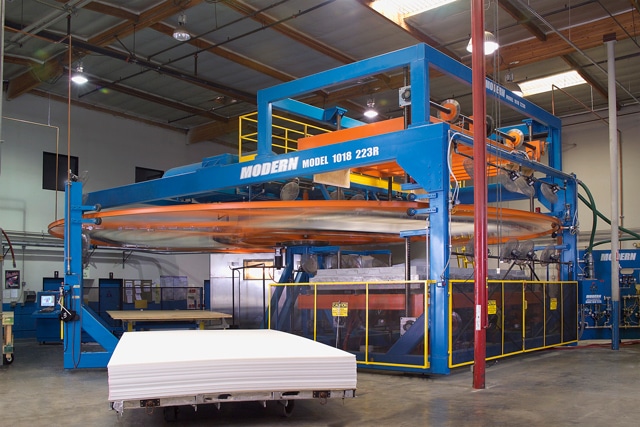One of the big reasons many designers enjoy working with thermoforming projects is that thermoformed materials can look great right out of the mold. With an essentially infinite variety of custom colors available, designers can create a thermoformed part in any color imaginable—without painting, and specify textures, from glossy-smooth all the way to rough mattes and other custom textures. “But what’s less well known is that, with thermoforming, molded-in color and texture are just the beginning,” says Jason Middleton, VP of sales and development at Ray Products. “Using more advanced techniques, you can use thermoforming to meet custom structure and durability requirements, simulate other materials or even meet your sustainability goals.”
Hot Stamp Films: Thermoforming’s Veneers
In woodworking, veneers are thin layers of hardwood or synthetic finishes used to give a specific look to structural elements. In thermoforming, hot stamp films work pretty much the same way. Hot stamp films can be printed with any pattern imaginable. Realistic wood grain? Sure. Metallic finishes? Absolutely. Camo? They’ll never see you coming! Custom patterns? Not a problem at all.
Hot stamp films also can be applied to almost any thermoplastic material. This allows for choices of underlying material characteristics, such as fire retardant capabilities or impact resistance, and the hot stamp finish of your choice. Generally, hot stamp films are applied in the factory where the thermoplastic is extruded. Since they have the hot stamp finish applied to the material before it’s thermoformed, it can be a very cost-effective option with a minimal impact on finishing costs.
Multi-Layer Sheets: The Best of Both Worlds
“Making decisions is hard,” says Middleton. “We want the best of both worlds: perfection without sacrifice. Thermoforming with multi-layered co-extruded sheets can feel like you’re getting exactly that. Multi-layered co-extrusions essentially give you a single sheet of thermoplastics made from two different materials.” Looking for a low-cost, 100 percent recycled base layer combined with a beautiful, virgin impact and weather-resistant outer layer? A multi-layered sheet of thermoplastic is the answer.
Order for the exact thickness and qualities of the base material and outer material needed. The base material can provide structure, while the outer material provides aesthetic appeal and durability. Multi-layered sheets are popular in food processing, automotive, bathroom and spa applications—where materials have very specific functional and structural requirements.
But Wait, There’s More!
With multi-part thermoformed assemblies, there is the option to combine several techniques to reach design goals. A single, multi-part thermoformed product could use in-color molding and texturing, painting, hot stamp films and multi-layered sheets. It’s all just one more reason to consider one of the most versatile plastic manufacturing processes available on your next project.
For more information, contact Jason Middleton, VP of sales and development, Ray Products at [email protected].
